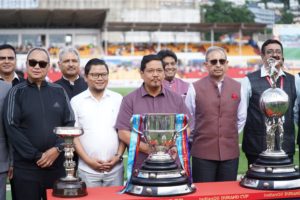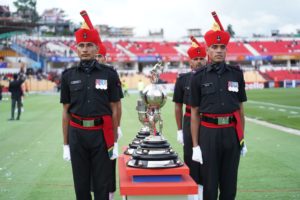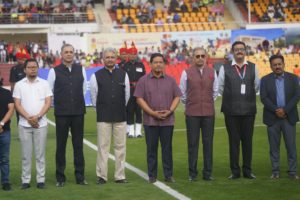When the clouds hang low over the pine-scented hills of Shillong and the drizzle dances on blades of grass, there’s a certain magic in the air — a rhythm, a pulse. This year, that rhythm beat to the sound of football boots and war cries of glory as the legendary Durand Cup — born in colonial barracks and raised through the decades of India’s footballing journey — returned to whisper its age-old tale in a new language: the language of the hills.
By Monojit Mandal
 If Shillong is the Scotland of the East, then this July, it became something else entirely — a living, breathing amphitheatre for football’s greatest old tale. As the 134th edition of the Durand Cup kicked off in Meghalaya’s capital for the second year running, one could almost hear the echo of spiked boots on British-era parade grounds, the thump of a stitched leather ball, and the roar of colonial troops and civilians alike—transported from 19th-century Shimla to the modern-day hill city of Shillong.
If Shillong is the Scotland of the East, then this July, it became something else entirely — a living, breathing amphitheatre for football’s greatest old tale. As the 134th edition of the Durand Cup kicked off in Meghalaya’s capital for the second year running, one could almost hear the echo of spiked boots on British-era parade grounds, the thump of a stitched leather ball, and the roar of colonial troops and civilians alike—transported from 19th-century Shimla to the modern-day hill city of Shillong.
Yes, the Durand Cup has come a long way.
 But like all great journeys, it began humbly. In 1888, in the military cantonment of Annadale near Shimla, Sir Henry Mortimer Durand — then India’s Foreign Secretary — introduced the tournament as a recreational affair for British Indian Army troops. Little could Sir Durand have known that his namesake cup would, nearly a century and a half later, command the attention of football fans from the dusty fields of Jharkhand to the misty meadows of Meghalaya.
But like all great journeys, it began humbly. In 1888, in the military cantonment of Annadale near Shimla, Sir Henry Mortimer Durand — then India’s Foreign Secretary — introduced the tournament as a recreational affair for British Indian Army troops. Little could Sir Durand have known that his namesake cup would, nearly a century and a half later, command the attention of football fans from the dusty fields of Jharkhand to the misty meadows of Meghalaya.
A Slice of Football History – Now in Our Backyard
Shillong hosting the Durand Cup isn’t just another notch in the city’s sporting belt. It’s a statement.
 The city, where football is a way of life and not just a game, has always been one of India’s underappreciated talent factories. So when the Durand Cup organisers added Shillong to the list of host venues in 2024, it wasn’t charity. It was poetic justice.
The city, where football is a way of life and not just a game, has always been one of India’s underappreciated talent factories. So when the Durand Cup organisers added Shillong to the list of host venues in 2024, it wasn’t charity. It was poetic justice.
And this year, the poem gets a second stanza.
From the floodlights of Kolkata to the foothills of Jowai, from the turf at Guwahati to the stands at Shillong’s JN Stadium, the Durand Cup has taken on the personality of a travelling festival — uniting the civilian and military, tradition and modernity, past and future.
With Meghalaya Chief Minister Conrad Sangma presiding over the opening ceremony amid chants, cheers, and confetti, the city’s embrace of the tournament wasn’t just ceremonial — it was spiritual. It’s not every day that Shillong becomes a piece of football’s living museum.
A Tournament Older Than Many Nations
 To put it in perspective, the Durand Cup is older than the FIFA World Cup (1930), older than even most of India’s political parties.
To put it in perspective, the Durand Cup is older than the FIFA World Cup (1930), older than even most of India’s political parties.
From its origins as an Army Cup for British regiments to a full-fledged, multi-city, pan-Indian competition, the Durand Cup has seen it all — World Wars, India’s Independence, Partition, the rise of ISL, and now, Shillong’s rise as a legitimate footballing destination.
 The first few decades saw domination by Highland and British infantry teams, but change began when Mohammedan Sporting from Kolkata lifted the trophy in 1940 — the first Indian civilian team to do so. That victory didn’t just break a monopoly; it broke a ceiling. A glass one. With studs.
The first few decades saw domination by Highland and British infantry teams, but change began when Mohammedan Sporting from Kolkata lifted the trophy in 1940 — the first Indian civilian team to do so. That victory didn’t just break a monopoly; it broke a ceiling. A glass one. With studs.
Post-Independence, the reins passed into the hands of the Indian Armed Forces under the newly formed Durand Football Tournament Society (DFTS), set up in 1950. In that very year, another piece of folklore was etched.
Enter Talimeren Ao: Captain, Midfielder, Goalkeeper, Legend
 Picture this: It’s the 1950 final. Mohun Bagan is 2-0 up, coasting. Their goalkeeper goes down with a serious injury. No substitutions are allowed back then.
Picture this: It’s the 1950 final. Mohun Bagan is 2-0 up, coasting. Their goalkeeper goes down with a serious injury. No substitutions are allowed back then.
So what does Talimeren Ao — India’s first Olympic football captain and a midfielder — do?
He walks to the goalpost and pulls on the gloves. No fuss, no drama. Just grit. Bagan go on to finish the game. And although the match itself may have faded from memory, Ao’s courage became immortalised.
For Shillong, and indeed all of Northeast India, Ao’s tale hits closer to home than most. He hailed from Nagaland, but remains a regional hero — a beacon for a generation that still believes football is a ticket to something bigger.
From the Capital to the Clouds
 Delhi hosted the Cup for over seven decades, from 1940 till 2014. Goa flirted with it briefly. But since 2019, the Eastern Command of the Indian Army — headquartered in Kolkata — has taken the Durand back to its emotional home: the football-mad heart of Bengal.
Delhi hosted the Cup for over seven decades, from 1940 till 2014. Goa flirted with it briefly. But since 2019, the Eastern Command of the Indian Army — headquartered in Kolkata — has taken the Durand back to its emotional home: the football-mad heart of Bengal.
And yet, even Kolkata, with its packed stadiums and boisterous rivalries, had to make space in 2022 — when Durand became a multi-city tournament for the first time.
That’s when the Northeast stepped in.
The inclusion of Shillong is not just geographical. It’s generational. It’s strategic. It’s long overdue.
The region has birthed giants — Eugeneson Lyngdoh, Aiborlang Khongjee, Redeem Tlang. Hosting the Durand is a symbolic handing over of the baton.
Three Trophies, One Legacy
 What makes the Durand Cup more prestigious than your average trophy cabinet dust collector is the sheer weight of its honours — literally and metaphorically.
What makes the Durand Cup more prestigious than your average trophy cabinet dust collector is the sheer weight of its honours — literally and metaphorically.
The champions take home not one but three trophies:
The Durand Cup (1888) — the original, the icon, the one with history carved into its brass belly.
The Shimla Trophy (1903) — a heartfelt gift from the people of Simla, who were so enamoured by the tournament that they presented a rolling trophy of their own.
 The President’s Cup (1956) — introduced by Dr. Rajendra Prasad, India’s first President, as a fresh symbol of national pride.
The President’s Cup (1956) — introduced by Dr. Rajendra Prasad, India’s first President, as a fresh symbol of national pride.
That’s not all — players also receive individual laurels for Best Player, Highest Scorer, and Best Goalkeeper. And some of these names? They’re now Indian football royalty.
In 1993, a 16-year-old from Sikkim named Bhaichung Bhutia scored a bicycle-kick goal in the Durand Cup. In 2002, a hungry 22-year-old named Sunil Chhetri announced himself at the very same stage. The rest is history — and still in motion.
The 2025 Bumper Edition
This year, the prize pool has tripled to ₹3 crore, thanks to IndianOil and the Eastern Command’s robust partnership. More than just a boost in numbers, it’s a reflection of the tournament’s growing stature and relevance in the modern era.
Live broadcasts across Sony Sports Network, increased digital footprint, and the sheer spread of the competition across five states — West Bengal, Jharkhand, Assam, Manipur, and Meghalaya — are reshaping the Durand Cup into a 21st-century giant with 19th-century roots.
Shillong’s Turn in the Spotlight
Shillong’s inclusion isn’t a favour — it’s a recognition.
A recognition of decades of grassroots efforts, of local clubs hustling in the shadows, of young boys chasing balls through monsoon puddles and hill slopes, hoping to become the next Ao or Chhetri.
It’s also a message to the rest of India: Talent doesn’t just live in academies and metros. It thrives in towns like Tura, Mawlai, and Nongthymmai.
So, as you sip your Sunday tea and flip through this edition of the newspaper, know this — the Durand Cup is not just passing through Shillong. It belongs here now.
In a world chasing instant gratification, the Durand remains a story of patience, evolution, and glorious endurance.
And perhaps that’s what football — real football — is all about. Not just who scores. But who endures.
Just like Shillong. Just like the Durand.



